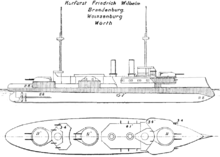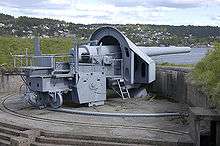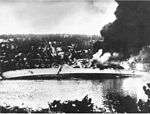28 cm MRK L/35
The 28 cm MRK L/35 was a German naval gun that was used in World War I as the primary armament of the Brandenburg-class pre-dreadnought battleships. It also saw use as a Coastal-defense gun during World War II.
| 28 cm MRK L/35 | |
|---|---|
A 28 cm gun at Oscarsborg Fortress | |
| Type | Naval gun Coast-defense gun |
| Place of origin | German Empire |
| Service history | |
| Used by | German Empire Ottoman Empire Norway |
| Wars | Boxer Rebellion World War I World War II |
| Production history | |
| Designer | Krupp |
| Designed | 1891 |
| Manufacturer | Krupp |
| Specifications | |
| Mass | 43.9 t (43.2 long tons; 48.4 short tons) |
| Length | 9.8 m (32 ft 2 in) L/35 |
| Barrel length | 8.95 m (29 ft 4 in)[1] |
| Shell | Separate-loading, bagged charge and projectile |
| Shell weight | 240 kg (530 lb) |
| Caliber | 283 mm (11.1 in) |
| Breech | Horizontal sliding-wedge |
| Elevation | -5° to +25° |
| Traverse | -150° to +150°[2] |
| Rate of fire | 1 round every two minutes |
| Muzzle velocity | 685 m/s (2,250 ft/s)[1] |
| Effective firing range | 11 km (6.8 mi) at 25° |
| Maximum firing range | 14.45 km (8.98 mi) at 25°[2] |
Design
The 28 cm MRK L/35 gun was a built-up gun made from three layers of reinforcing hoops. It used a cylindro-prismatic horizontal sliding breech, but unlike later Krupp guns it didn't use a metallic cartridge case. Instead, it used separate loading bagged charges and projectiles.[1]
The four ships of the Brandenburg-class had a slightly unusual arrangement for their primary armament. Although the primary armament consisted of six 28 cm guns in three twin gun turrets that all fired the same ammunition, the fore and aft turrets had 28 cm MRK L/40 guns, while the amidships turret had 28 cm MRK L/35 guns due to space constraints. The ships did not have centralized fire control and each gun type had different ballistics. The L/35 guns had a muzzle velocity of 685 m/s (2,250 ft/s) and a maximum range of 14.45 km (8.98 mi) vs 715 m/s (2,350 ft/s) and a maximum range of 15 km (9.3 mi) for the L/40 guns.[1]
Coastal defense
In addition to its role as a naval gun, the 28 cm MRK L/35 also saw use as a coastal defense gun. In 1893 Norway bought three guns on shielded coastal mounts to equip the Oscarsborg Fortress, which guards the Oslofjord that leads to the Norwegian capital of Oslo.[3]
When Norway was invaded on 9 April 1940 the three guns of the Oscarsborg Fortress together with shore mounted torpedo launchers sank the German Heavy Cruiser Blücher during the Battle of Drøbak Sound. This foiled a German naval landing which was attempting to capture Oslo and allowed the Norwegian royal family to escape.[4]
In 1910 two ships of the Brandenburg-class were sold to the Ottoman Empire and two ships remained in the High Seas Fleet until they were deactivated during World War I and scrapped after the war. When the two ships in German service were deactivated during World War I there were plans to convert the four guns to coastal mounts and deploy them to protect the Dardanelles. However, the fortifications they were planned to arm were never finished and the guns remained unused.[1]
Ammunition
| Wikimedia Commons has media related to Krupp 11-inch gun. |
Before and during World War I, the gun used about 56.6 kg (125 lb) of RP C/12 (Rohr-Pulver – tube powder)[2] propellant that was a mix of nitrocellulose, nitroglycerin and small amounts of other additives with a calorific value of 950 and an uncooled explosion temperature of 2,975 kelvins.[5]
| Shell name | Weight | Filling Weight | Armor Penetration |
|---|---|---|---|
| Armor-piercing shell (Panzergrenate L/2.6) | 240 kg (530 lb) | unknown | 160 mm (6.3 in) at 13.12 km (8.15 mi). |
| High-explosive shell (Sprenggranate L/2.9) | 240 kg (530 lb) | 15.9 kg (35 lb) HE | unknown[2] |
Photo gallery
 The Brandenburg-class as depicted in Brassey's Naval Annual 1902
The Brandenburg-class as depicted in Brassey's Naval Annual 1902 28 cm gun at Oscarsborg Fortress
28 cm gun at Oscarsborg Fortress 28 cm gun at Oscarsborg Fortress
28 cm gun at Oscarsborg Fortress The Blücher sinking
The Blücher sinking
References
- Friedman, Norman (2011). Naval Weapons of World War One. S. Yorkshire: Seaforth Pub. p. 137. ISBN 9781848321007. OCLC 751804655.
- DiGiulian, Tony. "Germany 28 cm/35 (11") MRK L/35 - NavWeaps". www.navweaps.com. Retrieved 2018-08-19.
- Goss.ru, Alex Goss -. "Northern Fortress: Oscarsborg > Main". www.nortfort.ru. Retrieved 2018-08-20.
- "Verneplaner". www.forsvarsbygg.no (in Norwegian). Retrieved 2018-08-20.
- Campbell, John (1985). Naval weapons of World War Two. Annapolis, Md.: Naval Institute Press. pp. 21. ISBN 0870214594. OCLC 13085151.